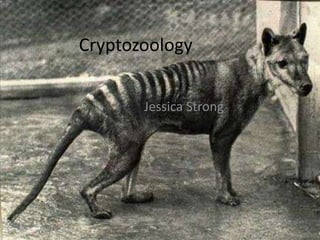Cryptozoology ppt
- 2. Contents âĒ Truth and skepticism â What is the history of cryptozoology? â How is cryptozoology viewed upon amongst the scientific community? âĒ Big foot â Some facts about sasquatch âĒ Nessie â Does the famous lake monster really exist? âĒ Chupacabra â What is this mysterious creature?
- 3. Truth and Skepticism âĒ Cryptozoology is the study of hidden or unknown species otherwise known as cryptids âĒ People have been recording sighting and traces of these animals for thousands of years. one in particular, about the Loch Ness Monster, dates back to as far as 565 A.D.
- 4. Truth and Skepticism âĒ Many species that have once been regarded as extinct or previously unknown to scientists, have been found in different areas throughout the world. Species have been known to elude scientists after being discovered, such as the Giant Panda, which took 67 years from the time it was discovered to the time a live specimen was caught. âĒ A list of some of the species that were one regarded as non- existent or extinct, but are now an accepted part of mainstream, zoology: Komodo Dragon, Giant Panda, Okapi, Pongo (also known as a gorilla), Gallotia Gomerana (lizard believed to be extinct for hundreds of years), Coelacanth (a fish believed to be extinct for millions of years until caught off the coast of South Africa)
- 5. Truth and Skepticism âĒ Cryptozoology often receives a bad reputation because it is usually practices with little skepticism, or regard for scientifically supported facts and theories âĒ It is not recognized by the scientific Community as a science and since there are no degrees given in this field, there is no such thing as a cryptozoologist.
- 6. Bigfoot âĒ Sasquatch, the cryptid from North America, first hinted to the world its existence in 1811, when Canadian trader David Thompson stumbled across several large footprints in the snow. Reportedly measuring fifteen by eight inches, near what is now Jasper Alberta âĒ The first ever recorded encounter with a Sasquatch-type creature took place in 1884, outside the small town of Yale, B.C., when a train crew came face-to-face with a long-armed manlike creature covered with coarse black hair. âĒ Since then, there have been hundreds, if not thousands of recorded encounters with âBigfootsâ
- 8. Loch Ness Monster âĒ The Loch is a 23 mile long stretch of water that is a mile wide and has an average depths of over 700 feet. It is located in the Great Glen which dicides the North of Scotland along a line from Fort William to Inverness. âĒ The Loch Ness Monster, or Nessie as it has been came to known, has been around for over a thousand years. When Saint Columba, a Christian missionary in Scotland, saved a swimmer from the monster by shouting âThink not to go further, touch not thou that man. Quick! Go back!â Ever since then, there have been Vague accounts of âSomethingâ in the Loch
- 10. Loch Ness Monster Sightings âĒ Loch Ness Monster Sightings Observer: D Mackenzie Time: 1200 Date: October 1871 Motion: Slow, then moved off at speed Description: Log like, then up-turned boat âĒ Observer: Roderick Matheson Time: Unknown Date: 1885 Motion: Forward Description: Described as the biggest thing I ever saw in my Life, neck like a horse with a mane. âĒ Observer: Alexander Macdonald Time: Early morning Date: 1888 Motion: Description: He called it salamander-like. âĒ Observer: Salmon Angler, Forester, Hotel Keeper and Fishing Ghillies Time: Unknown Date: 1895 Motion: Description: Observers reported that a horrible great beastie appeared in Loch Ness Observer: F Fraser, 2 others Time: Afternoon Date: December 1903 Motion: Could not get closer by rowing towards it. Description: Hump like upturned boat âĒ Observer: John Macleod Time: Unknown Date: 1908 Motion: Motionless, then moved off Description: Long tapering tail, eel-like head. 30-40ft, creature lying in the water, flush with surface âĒ Observer: William Miller and D McGillvray Time: 0730 Date: May 10th 1923 Motion: Stationary, moved off in arc, submerged. Description: 10-12ft like up-turned boat. âĒ Observer: Mrs Cumming and D McGillvray Time: 0930 Date: August 1929 Motion: Motionless, sank with a splash Description: Hump size of horse's body
- 11. Loch Ness Monster Sightings âĒ Observer: Ian J. Milne Time: 0730 Date: July 14th 1930 Motion: Splash, moved in an arc at 16-17mph, submerged Description: 2 or 3 shallow humps undulating along back. âĒ Observer: James Cameron Time: 1600 Date: Feb 7th 1932 Motion: Little or none, sank Description: Hump like up-turned boat âĒ Observer: Mrs Kirton and P.F.Grant Time: 1145 Date: 1933 Motion: Disturbance, moved about, great speed, disappeared and re-appeared 100yds away Description: 6ft by 1ft hump âĒ Observer: Mr and Mrs Mackay Time: 1500 Date: April 14th 1933 Motion: Commotion, wake, then humps, turned in arc then sank Description: 20ft overall, 2 humps, one larger âĒ Observer: Alexander Shaw and Alister Shaw Time: 1700 to 1800 Date: may 11th 1933 Motion: Wake, then hump moving faster than a rowing boat. Description: 8ft hump like a log âĒ Observer: Miss N Smith Time: 1400 Date: August 5th 1933 Motion: Moved circling, submerged Description: 1 hump, size of a rowing boat.
- 12. Chupacabra âĒ The Name Chupacabra means âGoat Suckerâ âĒ The first eyewitness account came from Angela Laje of Puerto Rico, who said the creature "looked like it belonged to the monkey family." Since then, chupacabra attacks have been reported in Russia, India, Central, South, and North America. âĒ Thirty-two turkeys and 30 sheep were reported dead, with all their blood drained. Later that year, the remains of an unidentified canine or rodent were discovered in Maine. The carcass was too badly damaged to be properly identified, but some believe that it was a chupacabra.
- 14. Bibliography âĒ http://4.bp.blogspot.com/_Qe1wgxDiEdU/TDMA axiXRcI/AAAAAAAAA6M/Adq4hpoH5IY/s1600/tas manian_tiger_wideweb__430x3053.jpg âĒ http://anythinghorror.files.wordpress.com/2011/ 05/bigfoot.jpg âĒ http://www.wired.com/images/article/full/2007/ 08/loch_ness_monster_580x.jpg âĒ http://dybiz.com/sites_randomblog/wp- content/uploads/2011/08/chupacabra_dead.jpg













